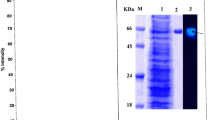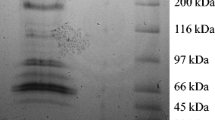Abstract
Aspergillus niger NRC 107 xylanase and β-xylosidase were immobilized on various carriers by different methods of immobilization, including physical adsorption, covalant binding, ionic binding, and entrapment. The immobilized enzymes were prepared by physical adsorption on tannin-chitosan, ionic binding onto Dowex-50W, covalent binding on chitosan beads through glutaraldehyde, and entrapment in polyacrylamide had the highest activities. In most cases, the optimum pH of the immobilized enzymes were shifted to lower than those of free enzymes. The optimum reaction temperature of immobilized xylanase was shifted from 50°C to 52.5–65°C, whereas that of immobilized β-xylosidase was shifted from 45°C to 50–60°C. TheK m values of immobilized enzymes were higher than those of native enzymes. The operational stability of the immobilized enzymes was evaluated in continuous operation in packed-bead column-type reactors. The enzymes covalently bounded to chitosan showed the highest operational stability. However, the enzymes immobilized by physical adsorption or by ionic binding showed a low operational stability. The enzymes entrapped in polyacrylamide exhibited lower activity, but better operational stability.
Similar content being viewed by others
References
Dekker, R. F. H. (1985), inBiosynthesis and Biodegradiation of Wood Components, Higuchi, ed., Inc, Orlando, FL, p. 505.
Yu, E. K. C. and Saddler, J. N. (1985),Trends Biotechnol. 3, 100.
Yu, E. K. C., Deschatelets, L., Louis-Seiz, G., and Saddler, N. J. (1985),Appl. Environ. Microbiol. 50, 924.
Kantelinen, A., Ranua, M., Rattoo, M., Viikari, L., Sundqvist, J., and Linko, M. (1988), inProceedings of the International Pulp Bleaching Conference, Tappi, p. 1.
Viikari, L., Kantelinen, A., Poutanen K., and Ranua, M. (1990), inProceedings of the 4th International Conference of Biotechnology in the Pulp and Paper Industry, Kirk, T. K. and Chang, H.-M., eds., p. 145.
Sharma, H. S. S. (1987),Appl. Microbil., Biotechnol. 26, 358.
Puls, J., Sinner, M., and Deitriches. (1991). US Patent No. 4275159, Class C12 N 11/18, C12 N 11/14, C12 N 9/14.
Oguntimein, C. B. and Reilly, P. J. (1980),Biotechnol. Bioeng. 22, 1127.
Roy, P. K., Roy, U., and Dube, D. K. (1984),J. Chem. Tech. Biotechnol. 34(B), 165.
Tavobilov, I. M., Rodionova, N. A., Baltsere, D., Yu. Aren, A. K., and Bezborodov, A. M. (1985),Prikl. Biochem. Microbiol. 21(6), 794.
Shimizu, K. and Ishihara, M. (1987),Biotechnol. Bioeng. XXIX, 236.
Abdel-Naby, M. A. and Kown, D. Y. (1992),Korean J. Appl. Microbiol. Biotechnol. 20(5), 543.
Adbel-Naby, M. A., El-Shaybe, N. M. A., and El-Diwany, A. I. (1992),African J. Agric. Sci. (in press).
Matsumoto, I., Mizuno, Y., and Seno, N. (1979),J. Biochem. 85, 1091.
Watanabe, T., Matuo, Y., Mori, T., Sano, R., Tosa, T., and Chibata, I. (1978),J. Solid-Phase Biochem. 3, 161.
March, S. C., Parikh, I., and Cuatrecasas, P. (1974),Anal. Biochem. 60, 149.
Weetall, H. H. (1970),Biochim. Biophys. Acta. 212, 1.
Dixon, J. E., Stolzenbach, F. E., Berenson, J. A., and Kaplan, N. O. (1973),Biochem. Biophys. Res. Commun. 52, 905.
Somogyi, M. (1952),J. Biol. Chem. 195, 19.
McGrath, R. (1972),Anal. Biochem. 49, 95.
Toldra, F., Jansen, N. B., and Tsao, G. T. (1986),Biotechnol. Lett. 8, 785.
Wong, K. K. Y., Tan, L. U. L., and Saddler, J. N. (1988),Microbiol. Rev. 52(3), 305.
Lomako, O. V., Menyailova, I. I., and Nakhapetyan, L. A. (1982),Enzyme Microb. Technol. 4, 89.
Siso, M. I., Grab, M., Condoret, J. S., and Combes, D. (1990),J. Chem. Technol. 48, 185.
Ohtakara, A., Mukerjee, G., and Mitsutomi, M. (1988), inProceedings of 4th International Conference on Chitin and Chitosan, Skjak-Break, G., Anthonsen, T., and Standford, P., eds., Trondheim, Norway, p. 643.
Kusano, S., Shiraishi, T., Takahashi, S.-I., Fujimoto, D., and Sakano, Y. (1989),J. Ferment. Bioeng. 68(4), 233.
Gottschalk, N. and Jaenicke, R. (1991),Biotechnol. Appl. Biochem. 14, 324.
Author information
Authors and Affiliations
Rights and permissions
About this article
Cite this article
Abdel-Naby, M.A. Immobilization ofAspergillus niger NRC 107 xylanase and β-xylosidase, and properties of the immobilized enzymes. Appl Biochem Biotechnol 38, 69–81 (1993). https://doi.org/10.1007/BF02916413
Received:
Accepted:
Issue Date:
DOI: https://doi.org/10.1007/BF02916413




